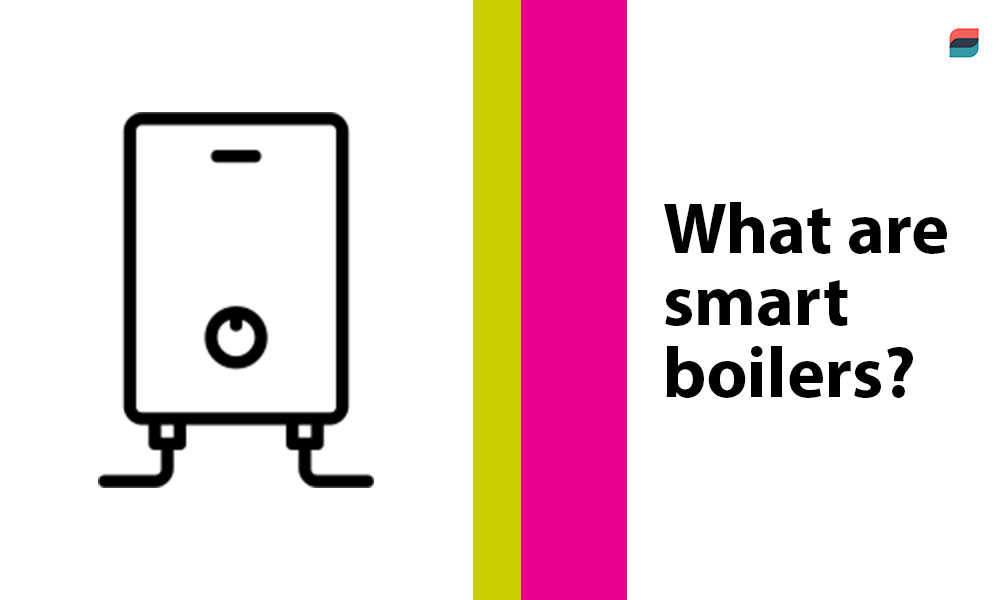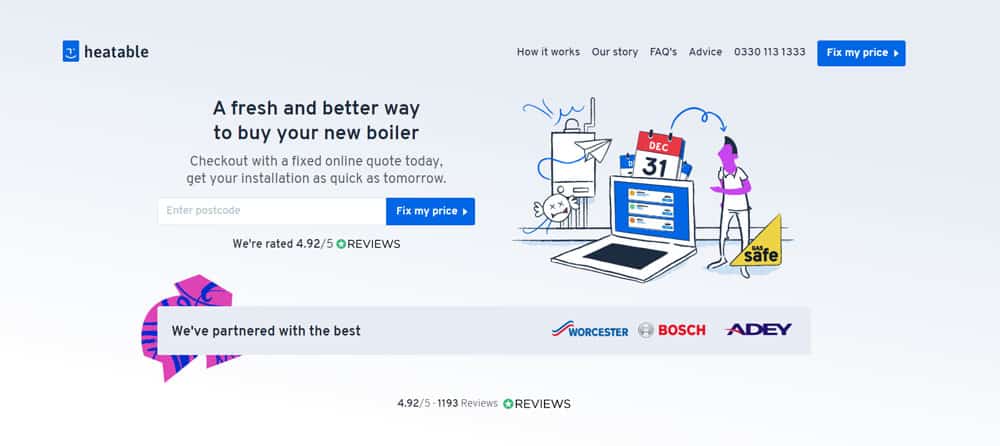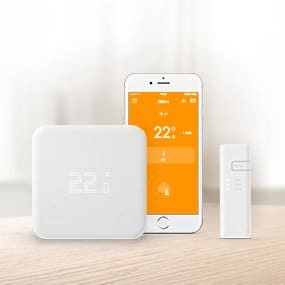Is a Smart Boiler Right For You? Here’s All You Need to Know
Smart homes let us integrate all our devices into a single point of control, typically from a mobile app, and a smart boiler is a key adjunct of the ‘smart home’ principle. We can tweak their settings and see their performance from our smartphones, while they can learn our heating habits, split our homes into heating zones, and help us slash energy costs.
In this post, we’ll tell you what smart boilers are, how they operate, whether they’re right for you, and show you the best smart boiler options on the market.

What Is a Smart Boiler?
Let’s start off by clearing the air — there’s no such thing as a “smart boiler” per se. A boiler itself is not smart. It just makes stuff hot; but, with commands from a smart thermostat, you get boiler controls that give ‘smarter’ heating outputs.
To make a boiler ‘smart’, you need to fit it with a ‘smart’, aka ‘learning’ or ‘intelligent’, thermostat. Which brings us to the next question:
What Is a Thermostat?
A thermostat is a device that controls the climate in your home and shows the current temperature. It sends your temperature setting to the boiler, which responds by heating the water in your pipes and radiators.
When the room temperature reaches the desired level, the thermostat senses this and sends the boiler a command to switch off. Once the interior cools off, the thermostat’s sensor feels the temperature change and activates the boiler once again.
The cycle we’ve described above varies, depending on the type of thermostat you have.
There are several types of these gadgets. They broadly fit into 3 groups: non-programmable, programmable, and smart.
Non-Programmable Thermostats
These are the most basic. Their name simply means that temperature adjustments cannot be pre-programmed. This device will maintain the input temperatures until switched off, or adjusted by hand.
Traditional non-programmable thermostats are operated mechanically, by shifting a lever.
However, their newer, digital counterparts have a digital temperature readout and can be operated with the push of a button.
Programmable Thermostats
These are not quite ‘smart’ yet, but they can regulate temperatures on their own. You just need to set the program for them through the thermostat controls; think of a coffee maker that’s set to start brewing first thing in the morning. It’s just like that.
Smart Thermostats
Smart thermostats are called ‘smart’, or ‘learning’ because they hone their patterns based on your heating behaviour. You don’t need to program one yourself. To learn properly, though, these gadgets need consistency from their users.
What’s more, smart thermostats ‘communicate’ with your boiler to monitor its performance, and show various aspects of its operation on your app. You can see how much energy is used at any given time, as well as system faults.
Paired with compatible boilers, zone valves, and room thermostats, some smart heating systems can also split your home into multiple heating zones. These features are meant to boost your comfort and curb energy use.
Programmable or not, thermostats have various means of connecting to the boiler and getting power. Some rely on batteries, whereas others are powered from the mains. Some are wired directly to the boiler, while the sleek modern versions hop onto your WiFi and send commands wirelessly.
Smart thermostats, being the most avant-garde, can ‘talk’ to the boiler wirelessly, and come with a mobile app for greater convenience. But before we talk about linking one of these devices to create a “smart boiler”, let’s dive into smart thermostats and find out how they work.
What kind of fuel does your boiler use?
Fixed price online with next day installation
How Does a Smart Thermostat Work?
As we’ve discussed, smart thermostats have 4 key features, which, in turn, make a “smart boiler”:
- You can control them remotely through a mobile app;
- They alert you to any system faults; and
- Smart thermostats program themselves based on your behaviour
- A smart thermostat can split your home into separate heating zones
Here’s How These Features Work:
Remote Heating Controls
To set up your remote controls, you’ll need a version of the following 3 components:
- A heating system (boiler, heat pump, what have you).
- A control centre. This can be a thermostat or any other interface that joins the heating system to the controlling device. Depending on boiler compatibility, it can have either a hard-wired or a wireless link to the boiler.
- An app for your mobile device that’s hooked up to the control centre, either via WiFi, Bluetooth, or other means.
With these 3 devices, smart thermostat control can be grouped into 3 basic functions: input, processing, and output.
- Input — This is where you enter a temperature setting from your app. If you’ve set up your system to learn and program itself, it may be the thermostat itself that gives this command.
- Processing — The control centre receives the command issued from the app and relays it to the heating system.
- Output — The heating system starts to produce heat to meet the temp setting.
The 3 components and the process itself may vary a bit depending on the boiler and thermostat make and model.
Monitor Boiler Performance
Much like in the sequence above, boilers can also send data back to the user. Energy usage, performance statistics, and faults can be gathered by the control centre and relayed to the user’s app.
The solutions for this function range between manufacturers, but in most cases the boilers must be compatible with the smart thermostat. It’s not just a matter of hooking up the latter to your new thermostat’s wires (which you can do if you don’t need this ‘talking’ feature, with systems like Worcester’s Wave).
Learn Your Heating Patterns
Smart thermostats note and ‘remember’ how, when, and where you heat your home throughout the day. By simply using the device for a while, you’re giving its learning technology enough data points to model your behaviour and create its heating program.
What’s more, some smart thermostats rely on sensors inside your home to discern when you’re away and adjust the heat settings accordingly. This feature helps your boiler use less fuel when it doesn’t have to. Then, if you always come back at a certain time, the smart device will know to crank up the heat just in time for your return.
Zone-Specific Heating
Zoning gives you control over the temperature in various parts of your home and helps you heat with more efficiency. With this function, heat is supplied only to those places where, and when, it’s needed most.
To add zones to your central heating system, you will need to invest in zone valves. These get fitted into your pipework for each zone that you want to create. Depending on the thermostat command, the valve opens or closes, controlling hot water flow to the radiator.
Because each zone you establish must be controlled separately, each will need a thermostat. These will work in concert with your app, and the control centre.
On a smaller scale, zone heating is also possible when you don’t have your own boiler. For instance, if you rent a flat, and all you get it a radiator. In this scenario, you can get a radiator thermostat to adjust the heat in your space, even though the boiler is out of your control.
Do these features sound enticing? Now, let’s learn how smart thermostats connect to boilers.
How Does a Smart Thermostat Connect to the Smart Boiler?
The smart thermostat you’re installing must be compatible with the boiler. You should establish that it is before you spend money on installing the boiler. If you’re buying both at the same time, the vendor will make sure that the two devices work together.

Check out Heatable’s awesome deals to find a boiler and thermostat that work for you!
With compatibility confirmed, you can now link your thermostat to the boiler.
The installation process will differ between brands. In some cases, it’s quite simple. For instance, with Worcester’s Wave, your technician may simply connect the new Wave thermostat in place of the old unit you’re replacing.
Here’s how they do it:
- Isolate the power to your boiler
- Isolate the power to the existing room thermostat(s)
- Remove existing thermostat(s) from the wall
- Fit the Wave wall mounting plate to the wall where the old thermostat used to be
- Connect the 2 thermostat cables to the cable clamps on the wall plate; these are not polarity-sensitive;
- Hang the thermostat on the wall plate, and lock it in place
- Connect the thermostat cables to the boiler’s EMS bus connection
- Restore power and turn on the boiler
- Connect the thermostat to the WiFi network
Viessmann’s Vitoconnect works much the same way. Of course, the connection process may vary with other brands. Some non-compatible boilers may need a retrofit to work with a smart thermostat, so you can expect to pay more for this extra step.
While performing the connection we described above may seem simple enough for a quick, DIY operation, leave this job to a Gas Safe engineer to ensure safety and proper connections. We cannot stress this enough – do not try to do this yourself!
Is a Smart Boiler Right for Me?
Smart boilers, or rather smart thermostats, may seem like a trendy new gizmo that eliminates the chore of setting temperatures. This learning technology is its most distinctive feature, but it may not be right for everyone.
For instance, if you work 9-5, and seldom stray from your schedule, a smart thermostat will quickly pick up your heating pattern and control your boiler efficiently. It will let the home cool while you’re gone, then heat it just as you arrive.
Is your location within the home equally predictable? Do you have zoned heating? Then your intelligent companion will learn to heat spaces when you’re there and let the others cool.
This will reduce your energy consumption even further.
But what if you’re a freelancer who’s in and out of the house as business dictates, with no discernable rhyme or rhythm in your daily schedule? Or a family of 6, with people coming and going all day? Even with today’s advanced AI technology, your smart thermostat will not keep up with you and its primary function will be rendered futile.
To Summarise
Smart thermostats are most useful when there’s consistency in your household routine. Without it, they’ll never learn, and you’re better off with a device that you can program — like UK’s very own, Alexa-compatible Hive thermostat.
That said, don’t forget their other cool features. Even if you must adjust the heating settings to match a changing routine, smart thermostats still offer remote control, zoned heat, holiday mode, and fault reports.
If you don’t think that smart heating can help you save money, you can probably find the right programmable thermostat that comes with an app for remote control.
The Worcester Wave from our example above fits the bill nicely. These units are Worcester’s top-tier smart home technology; and while they lack learning skills, you may program them for up to 7 days ahead. Their drawback is that multi-zone heating is sadly not an option. Luckily, they work well with a range of Worcester Bosch gas boilers, like these popular combi boiler models below:
- Greenstar i/i Junior/Si Compact/CDi Compact/Highflow CDi
And, these system boilers:
- Greenstar 12i/27i System
- Greenstar CDi Classic System
Keep in mind that older Worcester models may also be retrofitted to work with the Worcester Wave. Getting one will set you back around £250. If you’re looking for a boiler and thermostat, be sure to explore Heatable’s selection here and get their quote on boiler installations.

If you feel it’s that a truly ‘smart’ – aka learning thermostat – is a better fit for your home, let’s have a look at some leading systems on the market today.
What is the Best Smart Boiler?
While the Worcester Wave is a neat, heating control solution for your home climate, it is not truly ‘smart’, as it lacks the learning capacity. On the other hand, its leading Viessmann-sold competitor does not. So, let’s have a look at the true learning thermostats that will give you the best smart boiler you can have.
 Veissmann-tado° thermostat and app
Veissmann-tado° thermostat and app
This intelligent heat control system includes a wall and radiator thermostats, and a smartphone app. With its sensors, the system detects when no one’s home and sends the boiler fitting temp commands. The tado° also factors in the building type and current weather when adjusting the heat. By tracking your phone’s location and its radiator thermostats, it allows for simple zoned heating.
What’s cool about tado° is that it works with countless boiler models, including brand-new combi boilers, decades-old heat-only boilers, and even heat pumps.
You can order the tado° kit from the Viessmann Direct online shop for only £216.00, including VAT. If you want professional installation, which the manufacturer recommends, you’d still need to pay for it.
 Google Nest Learning Thermostat
Google Nest Learning Thermostat
If you want to integrate your heating and hot water into Google Home, look no further than the Nest Learning Thermostat.
It works with most combi, system, and heat-only boilers, radiant floor systems, as well as air and ground source heat pumps. It learns your heating patterns and offers the same suite of services most intelligent thermostats do.
With the Nest, you can split your home into heating zones, just be aware that you’d need to buy a separate thermostat for each zone you create. Needless to say, you can control the whole thing from your smartphone.
Oh, and the Nest integrates with Amazon’s Alexa too, if that’s your cup of tea.
Without installation, the Nest Learning Thermostat costs around £200.
Vaillant vSMART
With its vSMART app, this thermostat works with all currently available Vaillant boilers. It offers remote control over heat and hot water and learns from your behaviour from the moment you set up the system. It detects your absence and compensates for local weather conditions. With the vSMART app, you can control Valliant thermostats in other homes too – say, your holiday home, or parents’ house.
One notable drawback is that vSMART does not allow zone heating.
Expect to pay between £220-300 for this device, excluding installation.
Are Smart Boilers Worth It?
This has been a long read, so as we wrap it up, let’s take a look at the pros and cons of smart boilers and thermostats. We’ll kick off with the pros.
What are the pros of smart boilers?
- They learn your behaviour and tailor the heating pattern accordingly.
- Smart boilers allow remote control of heating and hot water.
- They allow multiple users to assume control over the app.
- Some let you split your home into zones and distribute heat with more efficiency.
- A smart boiler can communicate with the boiler and show you their performance data and faults.
- Some integrate with other elements of a ‘smart home’.
- Most are quite easy to install.
What are the cons of smart boilers?
For some households, a smart thermostat may not be worth the money. Let’s see why:
- They need consistency to learn your heating patterns. If your schedule alters often, the device will not be able to fulfill its primary function.
- Some are only compatible with boilers of the same manufacturer.
- Some are compatible with newer boilers only.
- Adding a handy feature, like zoned heat, can be pricey, as you would need to buy and install several zone valves and thermostats. So, a seemingly economical, £250-device quickly turns into a £1,000 investment.
The Bottom Line on Smart Boilers
Smart homes are an increasingly important trend. More and more smart home systems try to link all our devices under one umbrella. It only makes sense that heating and hot water integrate into such a hub. With intelligent programming, zoned heat, and remote control, smart boilers and thermostats help us slash unnecessary fuel use, lower our bills, and reduce our CO2 emissions. And they’re just convenient.
To summarise, smart boilers are right for you, if:
- your household’s schedule is fairly consistent
- you’d rather not worry about adjusting temp settings on your own
- investing in zoned heating seems like a good idea
- you prefer control and performance monitoring at your fingertips wherever you are
- you want more fuel efficiency with weather compensation
Stick to wireless programmable boilers if:
- your routine is unpredictable
- maintaining control over temp settings is important to you
- you will not be taking advantage of the zoned heating feature
Are you looking for a new boiler and thermostat? Heatable will quote you in under a minute and have your new boiler up and running as early as tomorrow!
What kind of fuel does your boiler use?
Fixed price online with next day installation
What’s Next?
Have you had an experience with smart boilers/thermostats that you’d like to share with our readers? If so, please leave a comment below!
